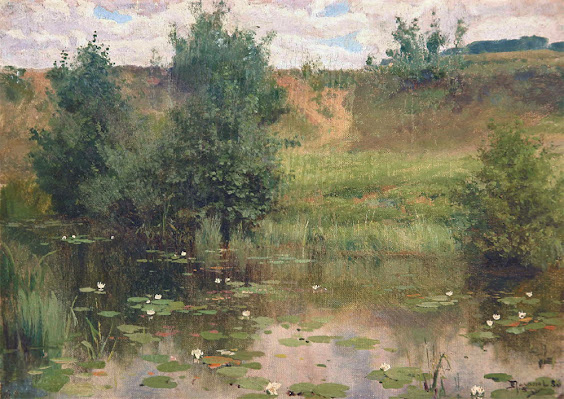Here is Vasily Polenov's depiction of the Lord's Last Supper. Notice at once he breaks ranks with the other artists who love symmetry and place Jesus in the middle with six apostles on one side and six on the other. Polenov shows the apostles gathered around with Jesus and each other. He is very interested in the room as well, which bears no resemblance to the Gothic room we might see if we've pilgrim-d to Jerusalem.
The ceiling is flat and made of planks of wood. The lighting is soft — there is a chandelier of oil lamps. There isn't a table as such, but a low platform with pillows around the perimeter. These are good Jewish men with covered heads. Jesus is standing on the right with his back to the wall — able to interact with all the dinner guests.
The meal is coming to its close. How do we know? We see Judas skulking off in the bottom left corner. He is going to tell the officials where they can find Jesus. Before he leaves the table, Jesus calls him friend.
But what really gets my attention is the strong beam of Full Moon light that is pouring in from the opening in the roof. An artist friend has told me that the hardest and most important thing to learn for an artist is how to paint light. This is clearly moon light isn't it, not sunlight. And look, that light is illuminating the clay jar. It's the clay jar that holds the water for the foot washing the apostles missed at the start of the meal. It is the Holy Thursday Gospel — John 13:1-15.
You see, there likely should have been a servant to wash everyone's dusty feet as they came in off the street. It doesn't matter why he was absent. Clearly, Jesus thought that in the absence of the servant, after three years together as attentive disciples (learners), one of them would have volunteered to offer that courtesy to the others. But halfway through the meal, it's clear no one has picked up on this, and so Jesus offers a last demonstration: This is how discipleship is done.
The light in this upper room is an intimate light. Christianity isn't about keeping distances, building barriers and walls, who's in/who's out. Christianity is a religion of intimacy, taking care of other people physically, making others comfortable — whether they are members of our blood family or the Central American unaccompanied minors showing up at the border fleeing for their lives. Or for pity's sake, wearing a mask during a pandemic. And no one should understand this better than those of us who approach the table and encounter the Lord, who as Mother Teresa says, "Wears the disguise of bread and wine."


























